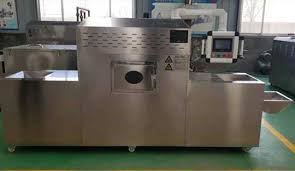Core Functionality: Efficient Moisture Removal
An industrial belt dryer is designed to efficiently remove moisture from bulk materials through a controlled and continuous process. This dryer type uses a conveyor or belt to transport material through different temperature zones, where heated air is passed through or over the material. The essence of this drying method is to use moderate temperatures over extended periods, which is ideal for sensitive or small materials that might be damaged by more intense drying methods.
Mechanism of Heat Transfer
The heat transfer in an industrial belt dryer occurs through convection. Hot air is generated by a heating system—commonly fueled by gas, steam, or electricity—and is then circulated over the material by fans. The air can be directed in various ways, either flowing through the material layers or across them, depending on the material type and the desired drying result. This flexibility allows for optimal drying conditions, as the airflow can be adjusted to the specific moisture content and heat sensitivity of the material.
Adjustable
Drying Parameters for Customized Results**
The strength of an industrial belt dryer lies in its ability to adjust drying parameters to match specific needs. Operators can control the temperature, airflow, and belt speed to fine-tune the drying process. Temperature ranges typically vary between 50°C (122°F) and 200°C (392°F), catering to a broad spectrum of materials from delicate herbs to robust wood chips. Adjusting the belt speed influences the residence time of the material in the dryer, allowing for more or less exposure to the heated air depending on the desired dryness level.
Versatility in Application
Industrial belt dryers are praised for their versatility. They handle a diverse array of materials including food products, chemicals, minerals, and biomass. Each dryer can be configured to suit the specific drying characteristics of the material, whether it requires gentle warming to preserve active ingredients or thorough drying for storage stability. This adaptability makes them invaluable in industries ranging from food processing to renewable energy where different materials need precise moisture control.
Energy Efficiency and Sustainability
Not only do these dryers operate effectively, but they are also designed for energy efficiency. Many modern industrial belt dryers incorporate heat recovery systems that reuse the heat from the exhaust air, dramatically reducing energy consumption. This feature not only cuts down on operational costs but also aligns with environmental sustainability goals, reducing the carbon footprint of industrial operations.
For more insights on how an industrial belt dryer can enhance your production process, check out our detailed guide.
By optimizing the drying process, industrial belt dryers provide a reliable solution that supports high-volume production with consistent results, making them a cornerstone in the manufacturing processes of numerous industries. Their ability to finely control drying conditions ensures high-quality output, making them a preferred choice for manufacturers looking to optimize both product quality and operational efficiency.
